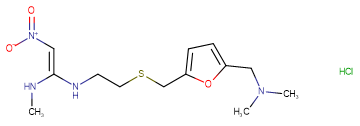
Noctone
CAS No. 66357-59-3
Noctone ( —— )
Catalog No. M15528 CAS No. 66357-59-3
Ranitidine is a histamine H2-receptor antagonist that inhibits stomach acid production.Ranitidine (Zantac) is a histamine H2-receptor antagonist with IC50 of 3.3 ± 1.4 uM.
Purity : >98%(HPLC)
 COA
COA
 Datasheet
Datasheet
 HNMR
HNMR
 HPLC
HPLC
 MSDS
MSDS
 Handing Instructions
Handing Instructions
| Size | Price / USD | Stock | Quantity |
| 25MG | 27 | In Stock |


|
| 50MG | 39 | In Stock |


|
| 100MG | 52 | In Stock |


|
| 200MG | 60 | In Stock |


|
| 500MG | 71 | In Stock |


|
| 1G | Get Quote | In Stock |


|
Biological Information
-
Product NameNoctone
-
NoteResearch use only, not for human use.
-
Brief DescriptionRanitidine is a histamine H2-receptor antagonist that inhibits stomach acid production.Ranitidine (Zantac) is a histamine H2-receptor antagonist with IC50 of 3.3 ± 1.4 uM.
-
DescriptionRanitidine is a histamine H2-receptor antagonist that inhibits stomach acid production.Ranitidine (Zantac) is a histamine H2-receptor antagonist with IC50 of 3.3 ± 1.4 uM. It inhibits stomach acid production. It is also used alongside fexofenadine.
-
Synonyms——
-
PathwayGPCR/G Protein
-
TargetHistamine Receptor
-
RecptorH2 receptor
-
Research AreaMetabolic Disease
-
Indication——
Chemical Information
-
CAS Number66357-59-3
-
Formula Weight350.86
-
Molecular FormulaC13H23ClN4O3S
-
Purity>98%(HPLC)
-
SolubilityWater: 70 mg/mL (199.5 mM); DMSO: 70 mg/mL (199.5 mM)
-
SMILESCN/C(=C\[N+](=O)[O-])/NCCSCC1=CC=C(O1)CN(C)C.Cl
-
Chemical Name——
Shipping & Storage Information
-
Storage(-20℃)
-
ShippingWith Ice Pack
-
Stability≥ 2 years
Reference
1.Pattichis K, Louca LL. Drug Metabol Drug Interact. 1995; 12(1):1-36.
molnova catalog


related products
-
Conessine
Conessine, a steroidal alkaloid isolated from Holarrhena floribunda, interacts with the histamine H3 receptor and has anti-malarial activity.
-
Tecastemizole
Tecastemizole is a selective antagonist of H1 receptor and a major metabolite of astemizole with anti-inflammatory effects.
-
Levocetirizine
Levocetirizine is a Histamine-1 Receptor Antagonist. The mechanism of action of levocetirizine is as a Histamine H1 Receptor Antagonist.



 Cart
Cart
 sales@molnova.com
sales@molnova.com


